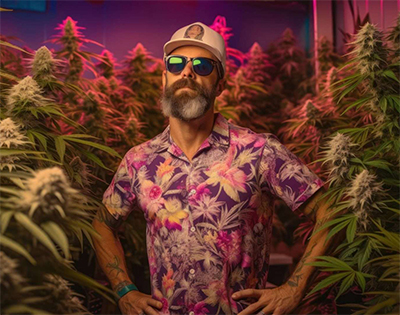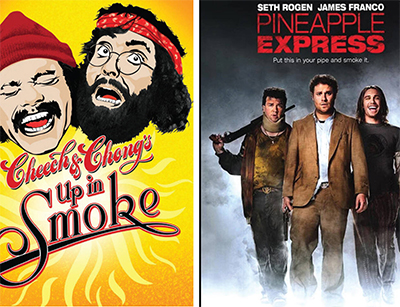Cannabis, once a symbol of counterculture, has transcended its controversial past to influence mainstream culture, especially within fashion and art. Today, we see the plant’s imagery on apparel, accessories, and in art forms that embody self-expression, community, and personal freedom. Cannabis’s gradual legalization and cultural acceptance have led to its newfound presence in creative industries, fueling a dynamic evolution in both fashion and art that celebrates cannabis in unique and imaginative ways.
The Roots of Cannabis in Art and Fashion
The history of cannabis in art and fashion has roots dating back centuries, with records of its influence on ancient textiles and art forms worldwide. In traditional Indian art, cannabis leaves appeared as decorative motifs, while ancient Chinese civilizations used hemp fibers in textiles and paper, incorporating cannabis plants as a symbol of endurance and adaptability. As cannabis reemerged in the 20th century, it became a defining element of countercultural movements, particularly in the 1960s and ‘70s when hippie fashion and psychedelic art embraced the cannabis leaf as a symbol of freedom and rebellion.
Throughout the ‘80s and ‘90s, cannabis use was increasingly depicted in art, though the plant retained a subversive image. It appeared in graffiti and street art, reflecting marginalized voices and alternative lifestyles. Hip-hop culture of the ‘90s, in particular, embraced cannabis imagery as artists like Snoop Dogg and Dr. Dre showcased their affinity for cannabis, incorporating it into music, lyrics, and visual aesthetics that challenged societal norms.
The Fashion Industry’s Modern Embrace of Cannabis
 In recent years, cannabis has moved beyond counterculture into high fashion, with luxury brands, designers, and models openly celebrating the plant. This shift began as cannabis legalization gained momentum across various states and countries, providing designers with newfound creative freedom to explore cannabis themes without fear of backlash. Notably, the cannabis leaf has become a symbol of the “green rush,” inspiring designs that range from subtle nods to bold statements.
In recent years, cannabis has moved beyond counterculture into high fashion, with luxury brands, designers, and models openly celebrating the plant. This shift began as cannabis legalization gained momentum across various states and countries, providing designers with newfound creative freedom to explore cannabis themes without fear of backlash. Notably, the cannabis leaf has become a symbol of the “green rush,” inspiring designs that range from subtle nods to bold statements.
Cannabis-Inspired Streetwear
Streetwear brands like HUF, Stüssy, and Supreme were among the first to popularize cannabis-inspired designs, incorporating bold graphics and slogans that resonated with younger audiences. These designs serve as symbols of lifestyle and community, celebrating a culture that unites enthusiasts through shared values and aesthetics.
Luxury Brands and Cannabis Couture
High-end brands have recently followed suit, albeit with a more polished approach. Designers like Alexander Wang, Jeremy Scott, and R13 have featured cannabis imagery in runway collections, using the plant to emphasize both exclusivity and progressive values. For example, cannabis-leaf motifs have been embroidered onto designer jackets, printed on handbags, and incorporated into custom accessories. Luxury brands use cannabis motifs to celebrate uniqueness, emphasizing its allure as a product of nature that pairs well with the organic, sustainable trends of the moment.
Sustainable Fashion and Hemp Fabrics
Hemp, derived from the cannabis plant, has emerged as a sustainable fabric choice in the fashion industry. Known for its durability, hemp is eco-friendly and requires less water and fewer pesticides compared to traditional cotton. As sustainability becomes a core focus for many fashion brands, hemp is increasingly used in clothing, shoes, and accessories. Companies like Patagonia and Levi’s have adopted hemp-based materials, not only for their environmental benefits but also to promote the positive aspects of the cannabis plant as a valuable, versatile resource.
Cannabis in Visual Art: A Creative Catalyst
 Cannabis has long served as both a subject and a source of inspiration in visual art, influencing a diverse range of styles, from surrealism to pop art. Its impact on creativity and self-expression has attracted artists who seek to challenge conventional boundaries and explore netvw perspectives.
Cannabis has long served as both a subject and a source of inspiration in visual art, influencing a diverse range of styles, from surrealism to pop art. Its impact on creativity and self-expression has attracted artists who seek to challenge conventional boundaries and explore netvw perspectives.
Psychedelic Art and Cannabis
Psychedelic art is perhaps one of the most prominent art forms associated with cannabis culture. In the 1960s, artists like Rick Griffin and Victor Moscoso created vibrant, mind-bending designs that visually encapsulated the experience of cannabis. These works became iconic representations of the psychedelic movement, and their influence remains visible in modern digital art, poster design, and album covers.
Cannabis-Infused Pop Art
As cannabis moved into mainstream culture, artists like Andy Warhol experimented with marijuana-themed art in a pop context, often using cannabis to comment on consumerism and modern society. Contemporary artists, such as Murakami and Shepard Fairey, continue this legacy by incorporating cannabis iconography into their work to make statements on social issues and celebrate cannabis as part of today’s cultural landscape.
Cannabis in Digital Art and NFTs
The digital art and NFT space has also embraced cannabis, with artists creating crypto art that highlights its cultural relevance. Some digital artists use cannabis-inspired visuals to create trippy, immersive experiences that parallel the effects of cannabis itself. By selling these artworks as NFTs, artists allow collectors to own a piece of digital cannabis culture, bringing cannabis-themed art into a new realm.
The Symbolism of Cannabis in Art
 Cannabis is often more than a mere subject in art; it’s a symbol representing themes like peace, unity, introspection, and freedom. For some artists, cannabis represents an escape from conformity and a medium for exploring consciousness. As a result, cannabis has taken on a transformative role, not only as a muse but as a statement against social injustices and restrictive policies.
Cannabis is often more than a mere subject in art; it’s a symbol representing themes like peace, unity, introspection, and freedom. For some artists, cannabis represents an escape from conformity and a medium for exploring consciousness. As a result, cannabis has taken on a transformative role, not only as a muse but as a statement against social injustices and restrictive policies.
Artists have also used cannabis as a means of destigmatizing the cannabis plant and humanizing its users. By portraying cannabis as a relatable, human-centered experience, art has contributed to changing public perception. Cannabis-centric art galleries and exhibitions showcase how artists use the plant to express personal stories, political beliefs, and visions for the future.
Social Media and Cannabis Aesthetics
Social media platforms have become central in spreading cannabis aesthetics to a global audience. Influencers, artists, and fashion icons regularly post cannabis-inspired content, from photos of luxury cannabis accessories to stylized images of cannabis plants. Instagram in particular has contributed to the rise of the “cannabis aesthetic,” where carefully curated images of cannabis products and paraphernalia appeal to a lifestyle-driven audience.
In addition to aesthetics, social media has helped normalize cannabis use and broadened its appeal across age groups and cultural demographics. Influencers like @weedandgrub have built large followings by promoting cannabis positivity through fashion, photography, and lifestyle content, reshaping cannabis from an underground activity to an acceptable, even aspirational, part of daily life.
Cannabis as an Inspiration in Music, Film, and Other Arts
 The influence of cannabis extends beyond visual art and fashion into music, film, and other creative forms. Genres like reggae, hip-hop, and rock have celebrated cannabis for decades, with iconic artists like Bob Marley, Snoop Dogg, and Willie Nelson advocating for the plant and incorporating it into their art. In cinema, cannabis themes appear frequently in cult films like Pineapple Express and Half Baked, which helped solidify cannabis’s place in popular culture as a source of humor and camaraderie.
The influence of cannabis extends beyond visual art and fashion into music, film, and other creative forms. Genres like reggae, hip-hop, and rock have celebrated cannabis for decades, with iconic artists like Bob Marley, Snoop Dogg, and Willie Nelson advocating for the plant and incorporating it into their art. In cinema, cannabis themes appear frequently in cult films like Pineapple Express and Half Baked, which helped solidify cannabis’s place in popular culture as a source of humor and camaraderie.
Cannabis is also present in more serious, thought-provoking works that address themes of identity, cultural struggle, and personal growth. From visual art to literature, cannabis’s ability to inspire and its role in society have solidified its position as a versatile, multi-dimensional muse for creators worldwide.
The Future of Cannabis in Fashion and Art
As cannabis continues its journey towards full acceptance, its presence in fashion and art is expected to grow, with future trends likely to see further integration of cannabis into mainstream culture. Emerging fashion designers may experiment with innovative hemp materials and bold designs, while digital artists could push the boundaries of cannabis-inspired virtual experiences, potentially creating virtual galleries and immersive art installations celebrating the plant.
On the art front, the rise of NFTs could create new opportunities for cannabis-inspired digital works to be collected and shared in the metaverse. The cultural power of cannabis is now a dynamic force, no longer confined by stigma or legality, but celebrated as a creative icon across mediums and genres.
Conclusion
The evolution of cannabis in fashion and art reflects broader changes in societal views toward the plant. Once relegated to counterculture, cannabis now symbolizes creativity, sustainability, and authenticity, captivating artists and designers who see it as more than a plant – but as a catalyst for innovation, unity, and self-expression. As cannabis culture continues to evolve, it will undoubtedly inspire new waves of creativity that shape the future of fashion and art, transforming cannabis into a timeless icon of human culture.
From the runway to the canvas, cannabis is making its mark – and it’s here to stay.

